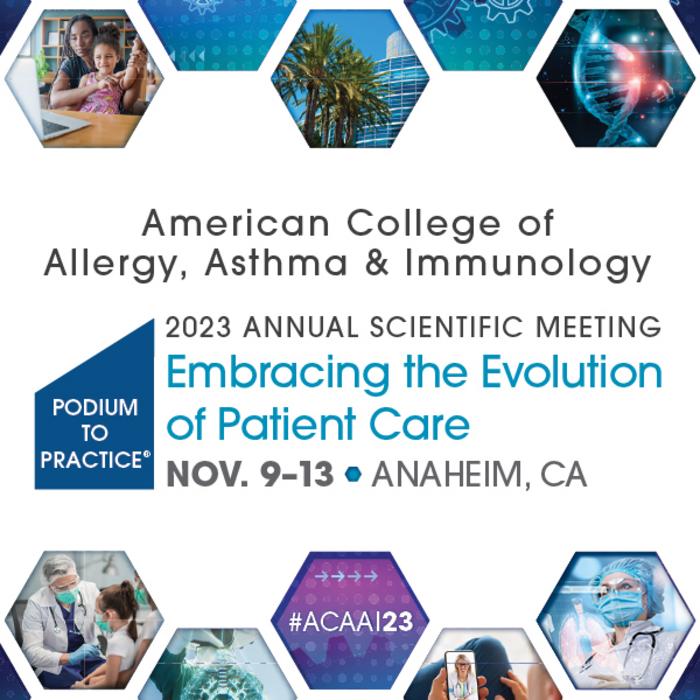ANAHEIM, Calif. (Nov. 9, 2023) – Severe weather events such as hurricanes, floods and extreme precipitation have increased in recent years and are projected to become more frequent. With those events can come a surge in growth of mold throughout houses and residences. Two new studies being presented at this year’s American College of Allergy, Asthma and Immunology (ACAAI) Annual Scientific Meeting in Anaheim, Calif. show the harmful health effects of excess mold on those with asthma, while also discussing methods for getting rid of mold and other airborne allergens in the most efficient way possible.

Credit: ACAAI
ANAHEIM, Calif. (Nov. 9, 2023) – Severe weather events such as hurricanes, floods and extreme precipitation have increased in recent years and are projected to become more frequent. With those events can come a surge in growth of mold throughout houses and residences. Two new studies being presented at this year’s American College of Allergy, Asthma and Immunology (ACAAI) Annual Scientific Meeting in Anaheim, Calif. show the harmful health effects of excess mold on those with asthma, while also discussing methods for getting rid of mold and other airborne allergens in the most efficient way possible.
“Allergists routinely discuss avoidance of mold with their patients who test positive for mold allergy,” said Amber Hardeman, MD, MPH, MBA, ACAAI member and lead author of the study. “We conducted a review of recent articles on flooding and mold exposure after natural disasters to assess the strength of evidence supporting common recommendations for mold remediation provided by physicians.”
Said the authors, “Post-storm, local hospitals witness a nearly twofold increase in diagnoses related to mold exposure. Individuals with respiratory conditions like asthma, weakened immune systems, and allergies are most at risk. Those with asthma face a two times higher risk of death when mold counts exceed 1000 spores/m3. A concentration of mold spores above 500 spores/m3 is considered high. In addition, concerns about mold exposure may lead to interventions such as bleach use, which can be more harmful than the mold itself. Allergists and other physicians should focus on recommending effective home drying methods and discouraging detrimental or expensive practices for patients exposed to mold.”
In a second study, researchers at the iAIR Institute examined interventions to improve indoor air quality (IAQ), such as source control, monitoring, and the use of air cleaners and said they can significantly improve health outcomes, particularly for people with asthma and allergies.
“This study provides an update on state-of-the-art air cleaning technology to equip doctors to advise their patients,” said Gráinne Cunniffe, PhD, lead author of the study. “HEPA filters remain most effective in removing airborne particles, including allergens and fine particulate matter. Additionally, activated carbon filters were found to be highly effective in removing volatile organic compounds (VOCs) and odors. UV-based technology can be effective when used in filtered HVAC systems.”
Air cleaners and ionizers that are ozone-producing were identified as technologies to consider cautiously as some have been shown to release harmful ozone gas. According to the authors, patients should also be encouraged to consider factors such as room size, cost, maintenance requirements, independent testing and third-party certification, and noise levels when selecting an air cleaner.
Abstract Title: Health Consequences and Remediation of Mold Exposure Following Natural Disasters: A Scoping Review
Presenter: Amber Hardeman, MD, MPH, MBA
Abstract Title: A Breath of Fresh Information on Air Cleaning Technology
Presenter: Gráinne Cunniffe, PhD
For more information about improving indoor air quality, or to find an allergist in your area, visit AllergyandAsthmaRelief.org. The ACAAI Annual Scientific Meeting is Nov. 9-13. For more news and research from the ACAAI Scientific Meeting, go to our newsroom and follow the conversation on X/Twitter #ACAAI23.
About ACAAI
The American College of Allergy, Asthma & Immunology (ACAAI) is a professional medical organization of more than 6,000 allergists-immunologists and allied health professionals, headquartered in Arlington Heights, Ill. Founded in 1942, the College fosters a culture of collaboration and congeniality in which its members work together and with others toward the common goals of patient care, education, advocacy, and research. ACAAI allergists are board-certified physicians trained to diagnose allergies and asthma, administer immunotherapy, and provide patients with the best treatment outcomes. For more information and to find relief, visit AllergyandAsthmaRelief.org. Join us on Facebook, Pinterest, Instagram and X/Twitter.
P037
HEALTH CONSEQUENCES AND REMEDIATION OF MOLD EXPOSURE FOLLOWING NATURAL DISASTERS:
A SCOPING REVIEW
A. Hardeman*, A. Hidalgo, E. Lindgren, J. Carlson, New Orleans, LA.
Introduction: With increasing global warming, the frequency of severe weather events, including floods and hurricanes, is rising. Allergists play a significant role in mold exposure remediation, evaluation, and providing guidance on remediation strategies.
Methods: We conducted a scoping review of recent articles on flooding and mold exposure after natural disasters to assess the strength of evidence supporting common recommendations for mold remediation provided by physicians.
Results: Moisture deteriorates building materials and furnishings, leading to mold growth and the release of material (e.g. spores and volatile organic compounds). Higher precipitation results in increased mold growth and aeroallergen levels, exacerbating air quality issues and triggering asthma in susceptible individuals. Post-storm, local hospitals witness a nearly twofold increase in ICD-10 diagnosis codes related to mold exposure. Individuals with respiratory conditions, weakened immune systems, and allergies are most at risk. Approximately 18% of the global population has asthma, highlighting the growing global health concern of mold exposure after floods.. Asthmatics face a 2.16 times higher mortality risk when mold counts exceed 1000 spores/m3. Concerns about mold exposure may lead to interventions (e.g., bleach use, airborne particles from home repairs) that can be more harmful than the mold itself.
Conclusion: Mold remediation is a complex field that requires further research to enhance safety guidelines. Allergists and other physicians should focus on recommending effective home drying methods and discouraging detrimental or expensive practices for patients exposed to mold.
P036
A BREATH OF FRESH INFORMATION ON AIR CLEANING TECHNOLOGY
G. Cunniffe*1, J. Whelan2, A. Byrne2, J. Ryan2, K. Lestage2, J. McKeon2, 1. Dublin, Dublin, Ireland; 2. Dublin, Ireland.
Introduction: Interventions to improve indoor air quality (IAQ), such as source control, monitoring and the use of air cleaners can significantly improve health outcomes, particularly for people with asthma and allergies. Doctors are a trusted source of information for patients. This study provides an update on state-of-the-art air cleaning technology to equip doctors to advise their patients.
Journal
Annals of Allergy Asthma & Immunology
Method of Research
Literature review
Subject of Research
Not applicable
Article Title
HEALTH CONSEQUENCES AND REMEDIATION OF MOLD EXPOSURE FOLLOWING NATURAL DISASTERS: A SCOPING REVIEW
Article Publication Date
9-Nov-2023




